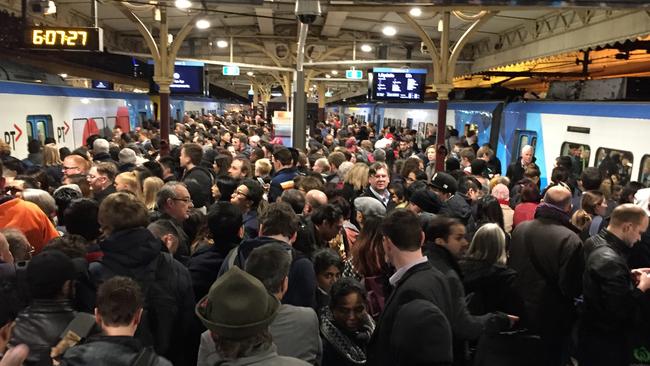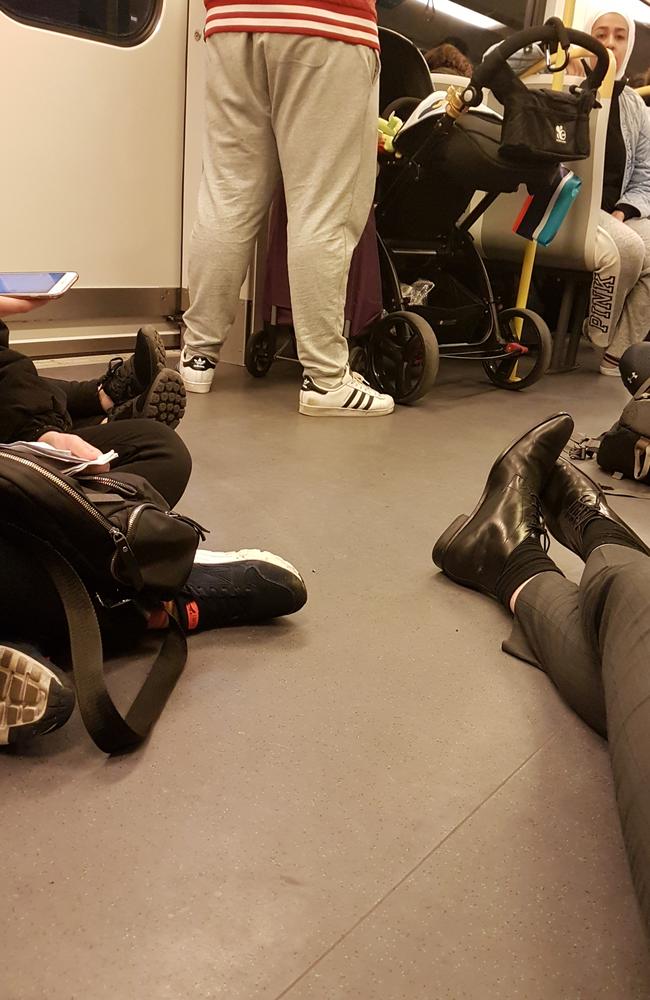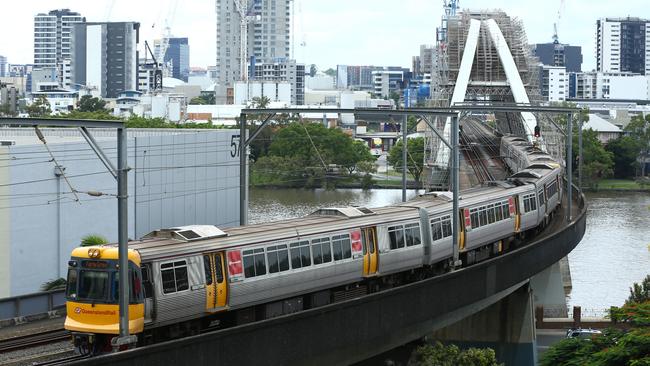Commuters hit by frequent shutdowns on our creaky, understaffed rail networks
IT’S the big rail fail — billions being spent on shiny new lines while the current system regularly leaves frustrated passengers stranded.
COMMUTERS just want to get from A to B as fast as possible. But across Australia, rail travellers are frequently departing A and then just stopping — sometimes for hours on end.
Our busiest rail networks are breaking down leaving exhausted passengers crammed together, dehydrated, or even in total darkness while transport bosses struggle to get the system running again.
This weekend, trains on a slew of Melbourne lines came to a grinding halt just as racegoers were heading to the Turnbull stakes.
Public Transport Users Association (PTUA) spokesman Daniel Bowen told news.com.au rail networks were not up to “21st century standards”, meaning minor glitches could fast become major delays.

“It’s a sign that not all is well on the train system if you have the sort of signalling and control room breakdowns that results in major disruption like this,” Mr Bowen said.
But Melbourne’s train operator Metro says trains, “have never been more reliable”.
On Saturday, trains on four Melbourne lines suddenly stopped just as extra services to Flemington were scheduled to crank up to ferry punters to the racecourse.
Metro said it was an isolated incident caused by a maintenance vehicle being out of position in the rail corridor.
One passenger stuck on a train told news.com.au that Metro had “just made an announcement that they basically won’t be able to fix anything within an hour or so”.

Melburnians could be forgiven for being exasperated as the unscheduled train failure and network stoppages pile up.
There’s even a hashtag so commuters can vent their anger on social media: #metrofail.
In August, peak hour passengers were forced to evacuate a train when an electrical fault caused a spark so big some thought an explosion had set the train on fire. The Fire Brigade said it was an “overhead wire issue”.
That incident was nothing compared to the great rail shutdown of July 13 2017.
At the start of the evening commute every single train in Melbourne stopped in its tracks due to a “computer fault”.

Some passengers were stuck in tunnels in stifling conditions. Metro was forced to plead with commuters stuck between stations not to attempt to open the doors of their train.
Last year, regional VLine services were thrown into chaos when the trains were banned from suburban tracks because it was revealed some were failing to properly activate level crossing gates.
Trapped in train for over an hour and about to piss myself @metrotrains
— Johnathan (@Johnathanvwebb) October 7, 2017
trains cactus - again ... no buses at camberwell so just fend for yourself ... nice @metrotrains
— Nathaniel Bane (@natbane) October 7, 2017
KY jelly needed to jam more people on trams due to @metrotrains failure #metrotrains #fail pic.twitter.com/cwF9c9eQR9
— Malcolm Pascoe (@malpascoe) July 13, 2017
Nobody going home at this rate. All trains stopped at Southern Cross. #Melbourne @theheraldsun #fridayfeeling #citylife @StevenGeorge36 pic.twitter.com/MTn0NMnDv9
— Sonny Wright (@DiscOfTron) July 7, 2017
It’s not just Victoria — in Queensland, commuters have their own train troubles. TransLink passengers have suffered from months of cancellations following a shortage of train drivers.
Last month, it was revealed less than 50 of the 200 new drivers need to restore reliability on the system had been trained, although Queensland Rail (QR) insists the worst is over.
In June, it wasn’t a lack of drivers but a technical fail that was the problem.
QR said a circuit breaker tripped and caused a communications failure which stopped all services for more than an hour on June 28.
Other cities aren’t immune from transport delays. A wiring issue on Sydney’s Harbour Bridge brought parts of the local network to a halt in December 2016.

But the incidents appear to be fewer and father between than in Melbourne.
“This issue is not unique to Melbourne which, like any big city, relies on mass transit to move people around efficiently,” Mr Bowen said. “When you shut down the network the whole city grinds to a halt.”
He told news.com.au a combination of a maintenance backlog and a lack of investment was to blame for the systems’ lack of resilience.
“It’s a long term problem, and governments on both sides have neglected public transport.
Currently, Melbourne is spending some $11 billion on building the new Metro tunnels that will cross the CBD and relieve congestion on the City Loop,” he said.
Mr Bowen said that investment would count for little if commuters on the new city line found themselves delayed because of shoddy maintenance further into the suburbs.
“You might climb on a train in a brand new and shiny station but by the time you hop off you could be on a single track platform with no shelter and no information screens as well as unreliable signalling,” he said.

“The train system is only as good as its weakest link. The network needs to be up to 21st century standards.”
Sammie Black, a spokeswomen for Metro, told news.com.au the Melbourne train contract had been made “tougher” and they were confident they would deliver.
“Since Metro took over the franchise to operate Melbourne’s trains in November 2009 they have never been more reliable,” she said.
“With the Victorian Government, we are investing more than $1 million each working day on maintenance and renewals with that figure set to increase more than thirty per cent under the new Franchise agreement.”
Investment in maintaining and renewing track, signalling and trains had gone from $8m to $12m per week.
Mr Bowen said Metro copped the flak for unscheduled stoppages. But they were sometimes the whipping boy for a lack of public investment.
Responsibility for Melbourne’s rail network is split between the privately owned Metro and the State Government. The two don’t always see eye-to-eye.
On Monday, it was revealed a Metro initiative that would allow passengers to use their phones to “scan” a train and the find out its destination was a lot further from fruition that expected.
Metro spruiked the new technology at an international conference in a slick video but has now downplayed any timescale for the app and is refusing to release the video, reported the Herald Sun.
“It’s good to look ahead to the possibilities of future technology, but this sounds like it’s stopping all stations to dreamland,” Mr Bowen said.
Melbourne is also finding its Myki system to be increasingly antiquated. One of the first Australian cities to replace paper tickets with smartcards, Melbourne is now playing catch up.
Sydney, whose Opal system came on line years after Myki, is now trialling payment directly from credit cards and mobile phones which could do away with smartcards altogether.
News.com.au has contacted Public Transport Victoria and Transport Queensland for comment.




